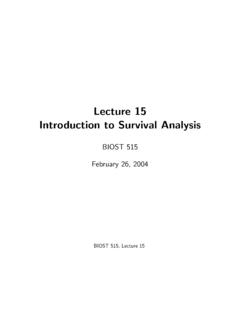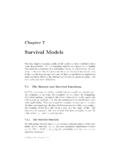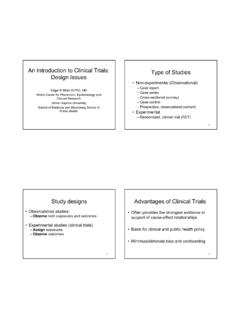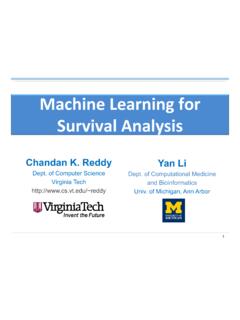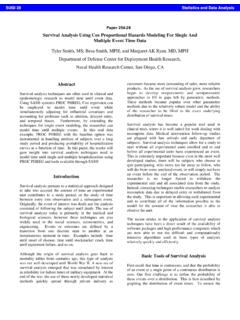Transcription of Weibull Analysis
1 STATGRAPHICS Rev. 5/29/2015 2013 by Statpoint Technologies, Inc. Weibull Analysis - 1 Weibull Analysis Summary .. 1 Data 3 Analysis Summary .. 4 Analysis Options .. 5 Weibull Plot .. 6 Frequency Histogram .. 9 Goodness-of-Fit Tests .. 10 Density Function .. 12 CDF .. 13 Survival Function .. 14 Log Survival Function .. 15 Hazard Function .. 16 Tail Areas .. 17 Critical Values .. 18 19 References .. 20 Summary The Weibull Analysis procedure is designed to fit a Weibull distribution to a set of n observations. It is commonly used to analyze data representing lifetimes or times until failure. The data may include censoring , in which some failure times are not known exactly due to removals of items from the test. The distribution is plotted and estimated percentiles are displayed. If desired, the data for more than one group may be specified. In such cases, a separate estimate of the distribution for each group will be derived.
2 Sample StatFolio: Weibull STATGRAPHICS Rev. 5/29/2015 2013 by Statpoint Technologies, Inc. Weibull Analysis - 2 Sample Data: The file contains the data from a life test on n = 38 shock absorbers, reported by Meeker and Escobar (1998). A portion of the data is shown below: Distance Censored 6700 0 6950 1 7820 1 8790 1 9120 0 9660 1 9820 1 11310 1 11690 1 11850 1 11880 1 12140 1 .. 28100 1 The Distance column represents the number of kilometers of use for each shock absorber when it was inspected. The Censored column contains a 0 for each absorber that had failed at the time of inspection and a 1 for each absorber that had not failed. All of the data contain information about the time until failure of the shock absorbers. For those that had failed, the observation is a true failure time. For those that had not failed, the observation is a right-censored failure time, with the actual time until failure known to be greater than the value indicated.
3 STATGRAPHICS Rev. 5/29/2015 2013 by Statpoint Technologies, Inc. Weibull Analysis - 3 Data Input The data input dialog box requests information about the failure times and their status: Data: numeric column with the n observed times. Censored: numeric column of 0 s and 1 s. A 0 indicates that the observation is not censored and therefore represents a true time until failure. A 1 indicates that the observation is right-censored, with the failure time known only to be greater than that indicated. Select: subset selection. STATGRAPHICS Rev. 5/29/2015 2013 by Statpoint Technologies, Inc. Weibull Analysis - 4 Analysis Summary The Analysis Summary displays a table showing the fitted Weibull distribution: Weibull Analysis - Distance Data variable: Distance censoring : Censored Estimation method: maximum likelihood Sample size = 38 Number of failures = 11 Estimated shape = Estimated scale = Specified threshold = Estimated mean: Estimated std.
4 Dev.: confidence intervals Shape: [ , ] Scale: [ , ] The 3-parameter Weibull distribution has a probability density function defined by: /exp)(1 xxxf (1) It has 3 parameters: 1. Shape parameter > 0 2. Scale parameter > 0 3. Threshold parameter The range of values for the random variable X . The mean and variance of the Weibull distribution are: 1)(XE (2) 211222)( XV (3) Often the threshold parameter is set to 0, resulting in the 2-parameter Weibull distribution. The Analysis Summary table shows: Sample size - the total number of observations n. Number of failures - the number of observations corresponding to uncensored failure times. STATGRAPHICS Rev. 5/29/2015 2013 by Statpoint Technologies, Inc. Weibull Analysis - 5 Estimated shape and scale the estimates of the shape and scale parameters, and . Specified or estimated threshold - the value of the threshold parameter.
5 Depending upon the settings on the Analysis Options dialog box, this parameter may either be estimated from the data or specified by the user. Estimated mean and standard deviation these values are calculated from the estimated or specified parameters. 95% confidence intervals confidence intervals for the estimated parameters. Method of estimation the method used to estimate the parameters. The default method is maximum likelihood, which is the same method used by the Distribution Fitting procedures, although other methods may be requested on the Analysis Options dialog box. Analysis Options The Analysis Options dialog box controls how the parameters of the Weibull distribution are estimated: Lower Threshold: Specify a value for the threshold parameter , or request that it be estimated from the data. If estimating , you must select the maximum likelihood method. Estimation Method: the method used to estimate the parameters.
6 Three choices are available: 1. Rank Regression Fits a line to the data on the Weibull Plot by regressing n values ln(Xi- ) against the plotting positions specified on the dialog box. 2. Maximum likelihood - Estimates the parameters by maximizing the likelihood function. STATGRAPHICS Rev. 5/29/2015 2013 by Statpoint Technologies, Inc. Weibull Analysis - 6 3. Weibayes - Estimates the scale parameter assuming that both the threshold and shape parameters are known and equal to the values indicated on the dialog box. Weibull Plot The Weibull Plot shows the uncensored failure times plotted on a logarithmically scaled horizontal X axis. Weibull percentEst.: MLES hape: : : : 11 Sample size: 38 If the data come from a Weibull distribution, the points should fall approximately along a straight line on this plot, which corresponds to the fitted Weibull distribution. STATGRAPHICS Rev. 5/29/2015 2013 by Statpoint Technologies, Inc.
7 Weibull Analysis - 7 Pane Options Confidence Intervals - adds likelihood ratio confidence intervals for Xp, the p-th percentile of the Weibull distribution. Percentile - calculates and displays the selected percentile. Histogram of Censored Values adds a histogram of censored data values. STATGRAPHICS Rev. 5/29/2015 2013 by Statpoint Technologies, Inc. Weibull Analysis - 8 Example: Plot Showing Confidence Bands, 90th Percentile, and Censored Histogram [ , ] Weibull percentEst.: MLES hape: : : : 11 Sample size: 38 The 90th percentile of Distance is estimated to be approximately 36,090 km. The 95% confidence limits range from 29,147 km to 56,447 km, corresponding to the bands around the fitted line. STATGRAPHICS Rev. 5/29/2015 2013 by Statpoint Technologies, Inc. Weibull Analysis - 9 Frequency Histogram The Frequency Histogram shows the distribution of the observations, together with the estimated density function: Fitted Weibull Distribution100010000100000 Distance048121620percentageUncensoredCen sored The presence of many censored values causes the curve to lie to the right of the observed histogram.
8 Pane Options STATGRAPHICS Rev. 5/29/2015 2013 by Statpoint Technologies, Inc. Weibull Analysis - 10 Number of classes: the number of intervals into which the data will be divided. Intervals are adjacent to each other and of equal width (before the logarithm is calculated). The number of intervals into which the data is grouped by default is set by the rule specified on the EDA tab of the Preferences dialog box on the Edit menu. Lower Limit: lower limit of the first interval. Upper Limit: upper limit of the last interval. Hold: maintains the selected number of intervals and limits even if the source data changes. By default, the number of classes and the limits are recalculated whenever the data changes. This is necessary so that all observations are displayed even if some of the updated data fall beyond the original limits. Group Number: if more than one group of data has been fit, the number of the group to be displayed.
9 Log Scale for X Axis: whether the horizontal axis should be displayed using logarithmic scaling. Goodness-of-Fit Tests The Goodness-of-Fit Tests pane performs up to 7 different tests to determine whether or not the data could reasonably have come from a Weibull distribution. For all tests, the hypotheses of interest are: Null hypothesis: data are independent samples from the estimated Weibull distribution Alt. hypothesis: data are not independent samples from the estimated Weibull distribution The tests to be run are selected using Pane Options. Goodness-of-Fit Tests for Distance Modified Kolmogorov-Smirnov D Weibull D Modified Form P-Value >= Small P-Values (less than if operating at the 5% significance level) lead to a rejection of the Weibull distribution. In the current example, the P-Value is large, suggesting that the Weibull distribution is a reasonable model for the data. The goodness-of-fit tests are described in detail for uncensored in the documentation for Distribution Fitting (Uncensored Data) and for censored data in Distribution Fitting (Censored Data.)
10 STATGRAPHICS Rev. 5/29/2015 2013 by Statpoint Technologies, Inc. Weibull Analysis - 11 Pane Options Include select the tests to be included. The available tests depend on the type of censoring . Calculate distribution-specific P-Values if checked, the P-Values will be based on tables or formulas specifically developed for the Weibull distribution. Otherwise, the P-Values will be based on a general table or formula that applies to all distributions. The general approach is more conservative (will not reject a distribution as easily) but may be preferred when comparing P-Values amongst different distributions. censoring select the type of data censoring . The types are defined as: Random - indicates that data values have been randomly censored. Random censoring occurs when values are censored for various reasons, not falling into either the Type I or Type II mechanism. Type I - indicates that the data are time-censored , , items have been removed from the test at a pre-specified time.

